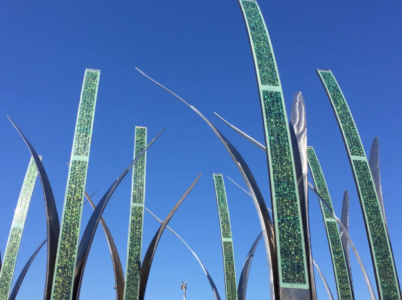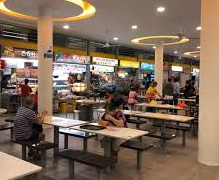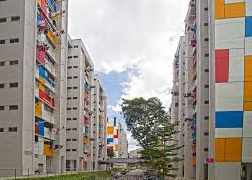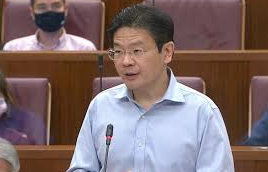Aesthetically designed solar panels are becoming ideal for vertical installations on buildings as Singapore’s green energy demand rises and rooftop space becomes limited.
SINGAPORE: The iconic blue Baba House at the National University of Singapore (NUS) is set to embrace sustainability with solar panels designed in traditional Peranakan styles, installed vertically on its façade.
These panels will adorn the sides of the three-storey townhouse located in Singapore’s historic Blair Plain district, marking a departure from the conventional horizontal placement of solar panels on roofs or the ground.
Approximately 20 to 30 modules will be mounted on the west-facing side of the house, allowing for optimal energy absorption during the afternoon, according to Mr. Mauro Pravettoni from NUS’ Solar Energy Research Institute of Singapore (SERIS), who spoke to CNA.
Once equipped with these patterned solar panels, along with traditional rooftop panels, the heritage house is projected to save around one-third of its electricity consumption.
Originally built around 1895 and once home to a Peranakan Chinese family, the restored townhouse is part of the NUS Centre for the Arts.
The artwork on the panels draws inspiration from Peranakan culture, tailored specifically to complement the historic design of the house, stated Ms. Karen Lim, curator of NUS Museum.
“We sought something customized for Baba House, recognizing it as an old heritage structure from the 19th century, which will impart a unique identity to the building itself. It reflects the blend of Peranakan culture in Singapore,” she said.
Ms. Lim envisions that this cultural landmark—a piece of Singapore’s history—will significantly contribute to a greener future for the country’s 6,500 shophouses.
“To us, this house is not just a building; it’s a living artifact,” Ms. Lim explained. “As we focus on conserving the house, the research data we gather will support Singapore’s sustainability efforts.”
“Our goal is to educate shophouse owners in Singapore and demonstrate that adopting renewable energy is feasible, fostering a collective response to climate change and global warming,” she said.
RISING SOLAR DEMAND
Solar installations are on the rise in Singapore, with residential fittings increasing by 154 and the private sector adding 55 fixtures in the first quarter of 2022 compared to the previous quarter, as reported by the Energy Market Authority.
Rising energy costs, increased awareness, and global environmental concerns are driving the adoption of solar energy, stated Mr. Lim Cheong Boon, head of Asia Pacific product and marketing at Trina Solar.
“We can also view it through the lens of energy security; solar installations can be placed on rooftops or within national borders, ensuring that energy will always be available, independent of imported sources,” Mr. Lim added.
Singapore aims to deploy solar energy sufficient to meet the annual needs of approximately 350,000 households by 2030.
Experts note that aesthetically designed solar panels, like those planned for NUS Baba House, can be well-suited for vertical installations as Singapore’s demand for green energy surges and rooftop space becomes scarce.
AESTHETICS VS. EFFICIENCY
However, vertical installations face challenges, primarily due to receiving less sunlight. Industry experts indicate that advanced technology is necessary before widespread adoption of vertical fittings can occur.
“Considering the energy output of vertical solar panels compared to conventional tilted installations, the power generation remains lower,” stated Mr. Lim. “We believe that the technology needs further development before we see widespread use of vertical solar solutions.”
While aesthetic designs can enhance the visual appeal of solar panels, this may lead to efficiency reductions of between 5 and 25 percent, depending on the design and color, according to Mr. Pravettoni.
The aesthetically pleasing modules at NUS Baba House could experience a 25 percent decrease in energy absorption compared to standard panels, yet Mr. Pravettoni noted that efficiency could be improved through the use of varied materials, textures, or designs.
“Colored panels—our rationale for this choice is to harmonize with the building’s façade. The idea is to create modules that satisfy certain aesthetic needs. In this case, the innovation lies in using repeated patterns,” he explained.
Mr. Pravettoni elaborated that the identical patterns on the Peranakan-inspired panels allow each solar cell to receive equal sunlight, potentially enhancing their efficiency and safety.
Despite the compromise on energy intake, he emphasized the importance of aesthetics.
“Aesthetics are crucial when integrated into a building; no one desires an unattractive structure. Therefore, it’s essential to create buildings that are visually appealing, so onlookers can admire them and say, ‘Wow, is that photovoltaic technology? That’s impressive!’,” he remarked.
HUGE FUTURE POTENTIAL
While vertical installations and patterned panels are still in the early stages, researchers see significant potential in integrating solar technology onto the many untapped building facades in Singapore.
“Throughout the city, high-rise buildings dominate, leaving less room for low-rise structures. The vertical surfaces on high-rise buildings offer more space than rooftops,” Mr. Pravettoni stated.
Beyond mounting solar panels, experts are exploring the integration of solar technology into buildings and along roadways.
“Another approach involves replacing building components, such as windows, with photovoltaic elements,” said Mr. Pravettoni.
“Much work remains to be done, but achieving this goal could enable most buildings in Singapore to incorporate photovoltaics into their facades,” he added.
“Other possibilities include utilizing solar panels as noise barriers along motorways or railways, providing sound protection while simultaneously generating electricity; these too can be installed vertically,” concluded Mr. Pravettoni.








